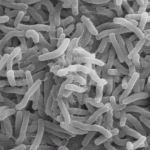Microbiology
|
26 august 2015 13:33:59 |
| The Escherichia coli NarL receiver domain regulates transcription through promoter specific functions (BMC Microbiology) |
|
Tweet Background:
The Escherichia coli response regulator NarL controls transcription of genes involved in nitrate respiration during anaerobiosis. NarL consists of two domains joined by a linker that wraps around the interdomain interface. Phosphorylation of the NarL N-terminal receiver domain (RD) releases the, otherwise sequestered, C-terminal output domain (OD) that subsequently binds specific DNA promoter sites to repress or activate gene expression. The aim of this study is to investigate the extent to which the NarL OD and RD function independently to regulate transcription, and the affect of the linker on OD function.
Results:
NarL OD constructs containing different linker segments were examined for their ability to repress frdA-lacZ or activate narG-lacZ reporter fusion genes. These in vivo expression assays revealed that the NarL OD, in the absence or presence of linker helix α6, constitutively repressed frdA-lacZ expression regardless of nitrate availability. However, the presence of the linker loop α5-α6 reversed this repression and also showed impaired DNA binding in vitro. The OD alone could not activate narG-lacZ expression; this activity required the presence of the NarL RD. A footprint assay demonstrated that the NarL OD only partially bound recognition sites at the narG promoter, and the binding affinity was increased by the presence of the phosphorylated RD. Analytical ultracentrifugation used to examine domain oligomerization showed that the NarL RD forms dimers in solution while the OD is monomeric.
Conclusions:
The NarL RD operates as an on-off switch to occlude or release the OD in a nitrate-responsive manner, but has additional roles to directly stimulate transcription at promoters for which the OD lacks independent function. One such role of the RD is to enhance the DNA binding affinity of the OD to target promoter sites. The data also imply that NarL phosphorylation results in RD dimerization and in the separation of the entire linker region from the OD. |
| 144 viewsCategory: Microbiology |
 Acquisition of the lac operon by Salmonella enterica (BMC Microbiology) Acquisition of the lac operon by Salmonella enterica (BMC Microbiology)Comparative analysis of multiple inducible phages from Mannheimia haemolytica (BMC Microbiology) 
|
| blog comments powered by Disqus |
MyJournals.org
The latest issues of all your favorite science journals on one page
The latest issues of all your favorite science journals on one page



